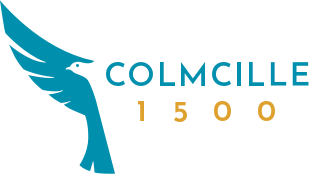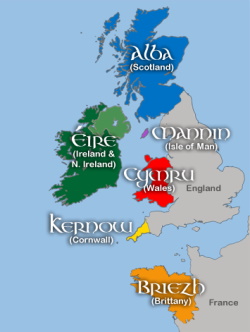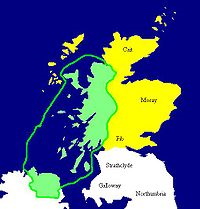Inter-Gaelic Celebration of Saint Columba - Colmcille 1500

An inter-Gaelic commemoration is now underway marking the birth 1500 years ago of the 6th-century saint Colmcille or Columba. His legacy has contributed to the development of the language, culture and traditions of the Gaelic nations of Ireland (Irish: Éire), Scotland (Scottish Gaelic: Alba) and the Isle of Man (Manx Gaelic: Mannin). He had a significant impact upon the course of Scottish and Irish history. Saint Columba’s legacy continues to be of relevance today.
The year-long inter-Gaelic celebration lasts from 7th December 2020 until 7th December 2021. However, it is hoped this celebration of the legacy of Colmcille is not only confined to his historical contribution, but an inspiration to future cooperation across all of the Gaelic countries and Gaelic speaking communities around the world. Gaelic was the Celtic language spoken by Columba and his followers. The Goidelic or Gaelic languages of Ireland, Scotland and Isle of Man form one of the two groups of Celtic languages still spoken in the world. The other being the Brittonic languages of Brittany (Breton: Breizh), Cornwall (Cornish: Kernow) and Wales (Welsh: Cymru).

Saint Columba also known as Colum Cille, or Chille (Old Irish, meaning 'dove of the church'), Colm Cille (Irish), Calum Cille (Scottish Gaelic), Columb Killey (Manx Gaelic) is thought to have been born on the 7 December 520 or 521AD near Gartan, which was part of Tyrconnell (Irish: Tír Chonaill), now in modern County Donegal, in Ireland. Columba's father was said to be Fedlimid and is recorded as being a descendent of an Irish King, Niall Noígíallachand. His mother Eithne of the Cenel Conailla, was a descendent of Cathair Mór a former King of Leinster. This royal lineage placed Columba in line to the throne of the Uí Néill clan.
Much of what is known about Saint Columba's life is recorded in the hagiography Vita Columbae "The Life of St Columba". It was written a century after Columba’s death by Adomnán of Iona. He was Abbot of Iona from 679 until his death in 704 AD. It is recorded that Columba’s early career involved him being trained in poetry and the bardic tradition under a Christian bard named Gemman and he studied at a series of monastic schools most notably under Finnian of Moville and Finnian of Clonard
Columba was ordained as a priest by Bishop Etchen in 551 AD. He is known as one of the ‘Twelve Apostles of Ireland’ (Irish: Dhá Aspal Déag na hÉireann). These were the twelve early Irish monastic saints of the sixth century who studied under St Finnian. During his early career Columba was involved in the establishment of a number of monastic settlements including most notably in Derry (Irish: Doire) c. 540. Columba/Colmcille is the patron-saint of the city of Derry.
It was from Derry, in 563AD that Columba, along with 12 disciples set sail for Dál Riata also known as Dalriada in Scotland. At that time Dál Riata was a Gaelic kingdom that encompassed the western seaboard of Scotland and the north-eastern corner of Ireland. Conall mac Comgaill was king of Dál Riata and a cousin of Columba. It is said he granted the Island of Iona (Scottish Gaelic: Ì Chaluim Chille) to Columba in order for him to settle and found his monastic community. Iona Abbey became an important centre of Gaelic monasticism for three centuries. It was from this base that Columba would spend the rest of his life undertaking missionary activity throughout Scotland. Particularly amongst the Pictish people of Scotland.
One interesting story in Adomnán’s account of St Columba’s life is the first recorded sighting of the famous Loch Ness Monster. It was on 22 August 565 AD when Columba came across a group of people burying a man by the River Ness during his journey through the lands of the Picts. Columba was told that the man had been attacked by a “water beast” which had dragged him under the water. In this story Columba sent his follower Luigne moccu Min to swim across the river. When the beast came after him, Columba made the sign of the cross and ordered the beast to leave and the monster fled.

It is recorded that after his arrival in Scotland that he only went back to Ireland once. However, it is thought that his links also helped to negotiate the political relationship between the Uí Néill clan and the Dalraidian kingdom. For the Gaelic warrior kings of Dál Riata, it is not hard to see how Columba was a useful asset. He was a trusted advisor to the King, his monastery provided a high level of education for their sons, as well as serving as a diplomat to the king's neighbours in the Pictish kingdoms and Ireland.
Saint Colomba died on Iona on 9th June 597 and this date is celebrated as his Feast Day, which is the annual religious celebration of a day dedicated to a particular saint. It is said that Columba's relics were removed in 849 and divided between Scotland and Ireland. King Kenneth 1, who has been considered to be the founder of the Kingdom of Alba (Scotland), sent them for safekeeping to Dunkeland and Ireland where they were reputedly buried in Downpatrick, County Down, with St. Patrick and St. Brigid.
In celebrating the life of Colmcille/Columba there is a recognition of the important legacy of his influence on the shared Gaelic traditions of Scotland, Ireland, the Isle of Man and in other areas of the world where Gaelic people have settled. It is also clear that Columba and his followers had a major influence on religious and spiritual life.
Read more
- Pan-Celtic
- English






